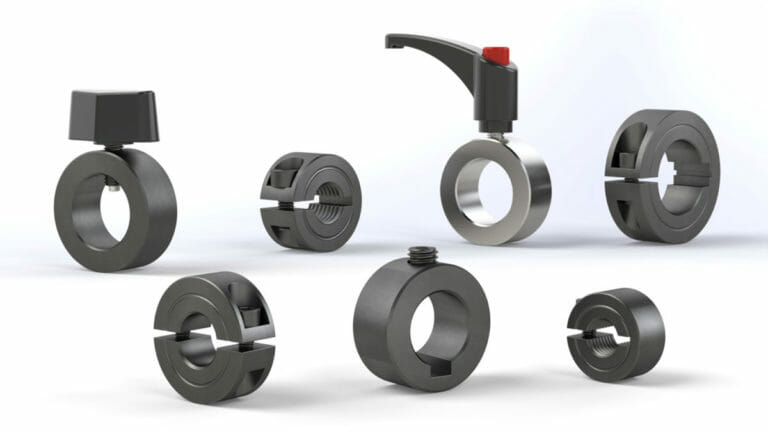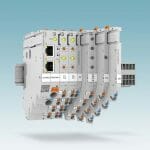Choosing the right shaft collar will impact the security and precision of clamping, not to mention the ease of installation and future maintenance. With a variety of styles and sizes available, whether your requirement is to mount tooling or a gear system, it’s crucial that you choose the right shaft collar for your application needs.
Sam Wilkinson, Design Engineer at WDS Components Ltd, explains how to choose the right shaft collar.
Shaft collars are used across a wide variety of applications for clamping and positioning components to a shaft. Attaching tools or fittings, as well as machinery and transmission applications such as bearings, gearboxes and motors, shaft collars are a simple, secure and versatile way of clamping. There are several versions of clamp available, and they mainly differ depending on the level of tightness and accuracy of clamping required, the impact to the shaft, and the flexibility of adjustment.
The standard set collar is both the most economical solution and is also fast and easy to use. The collar is slid around the shaft and a set screw or grub screw is tightened directly onto the shaft, securing the collar in place. The screw can be loosened to freely move the collar to the desired position for locating and clamping functions. While the standard, single piece set collar is fast and easy to use, the strength of the clamp relies on the single point of pressure exerted by the screw. This approach is often sufficiently secure for a variety of standard applications. As the screw directly comes into contact with the shaft, nylon or brass screw tips can be provided if a blemish-free appearance is required.
Alternatively, a semi-split shaft collar performs the same functions as the standard set collar, but, as a result of its design, it provides a more secure clamp. The design includes a collar with a split on one side. The cap screw, used to tighten the collar, runs through the side of the collar itself and doesn’t come into contact with the shaft. Tightening the screw creates pressure all around the shaft, providing clamping force through 360°, which also creates more precise clamp locating. This approach also ensures no damage to a single point on the shaft itself. Thanks to the side location of the screw, this also provides easy access to adjust the clamp as desired.
Double-split shaft collars take the principle of the semi-split shaft but continue the split all the way through the clamp, creating a clamp with two distinct halves, secured by a screw at either side, 180° apart. The double-split shaft collar has the same benefits as the semi-split collar, including 360° clamping pressure for a more secure hold and improved clamping location. However, as the clamp is comprised of two halves, it allows for greater flexibility in terms of installation.
For applications where the clamp is used on a shaft that’s difficult to access, or if the shaft is long or includes components such as transmission or bearings, it can prevent the collar from being slid on or off the shaft without removing other equipment – or even the shaft itself. The benefit of the split collar means the clamp can be easily separated and adjusted without the need to remove the shaft or adjoining equipment. This clamping approach can save significant resources in terms of maintenance and installation.
Threaded shaft collars are also available in a single-split collar format. With a threaded centre bore, this type of collar can be adjusted with greater precision and locked with an increased axial force compared to using standard clamping screws. At WDS, the threaded shaft collars are very finely machined to provide optimum accuracy and clamping, which also increases repeatability of installation positioning.
Keywayed shaft collars are a new introduction at WDS and are available in set, single-split and double-split collar variations. This design includes a key groove or slit, broached into the body of the collar. Keywayed shaft collars can be used on shafts with a key, where a slot is typically cut into the end of a shaft and a key inserted, onto which the collar can push against and lock into position. This prevents the shaft collar from rotating, even if the clamp is loosened, and as a result these types of collars are a secure way of clamping for applications such as gears. WDS can also provide parallel shaft keys to create this package.
For each of the collars offered by WDS there are wide variety of sizes, including 41 sizes in total across set, single- and double-split collars. This ranges from 12mm shaft bore up to 56mm across the range of standard industrial shaft sizes, and all sizes and styles are also carried in stock. Sizes are also etched onto the collar for improved identification. The collars are offered in mild steel with a black oxide protective coating to prevent rust, and stainless steel versions are also available. The collars are also complemented with a variety of handle styles.
Choosing the right shaft collar for your application is crucial, but with the right advice, making the optimum match is straightforward. To help identify the right shaft collar for your application, WDS’ customer support team is available. Just ring 0333 043 5443 or use the online contact form to send a direct message.








